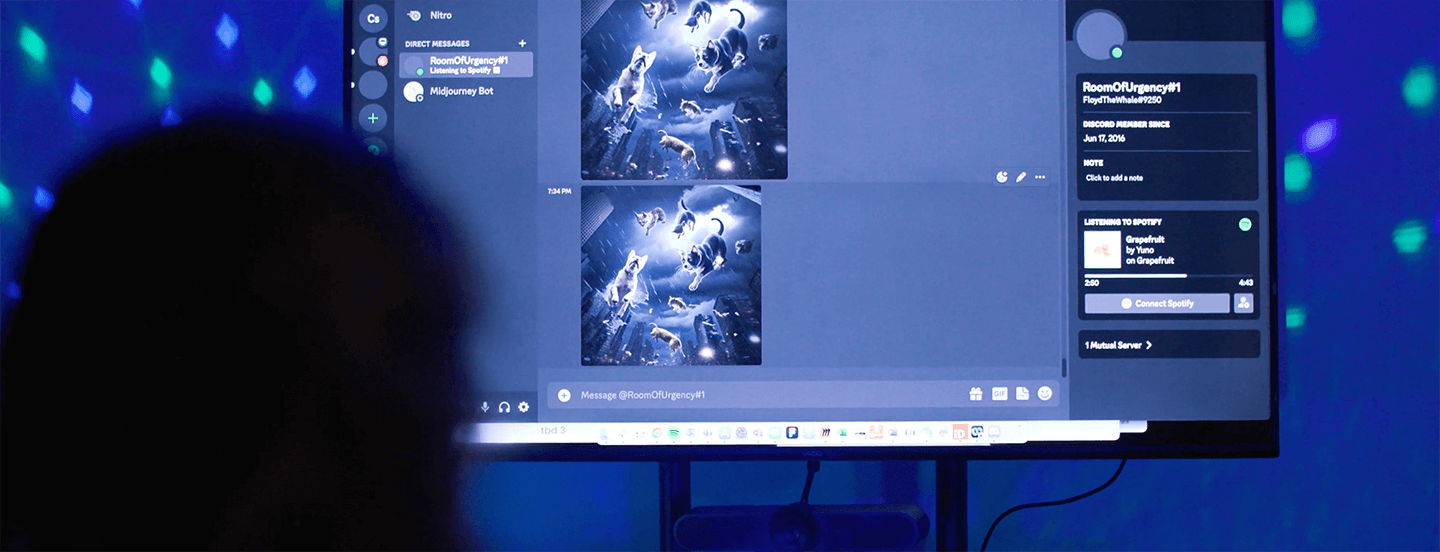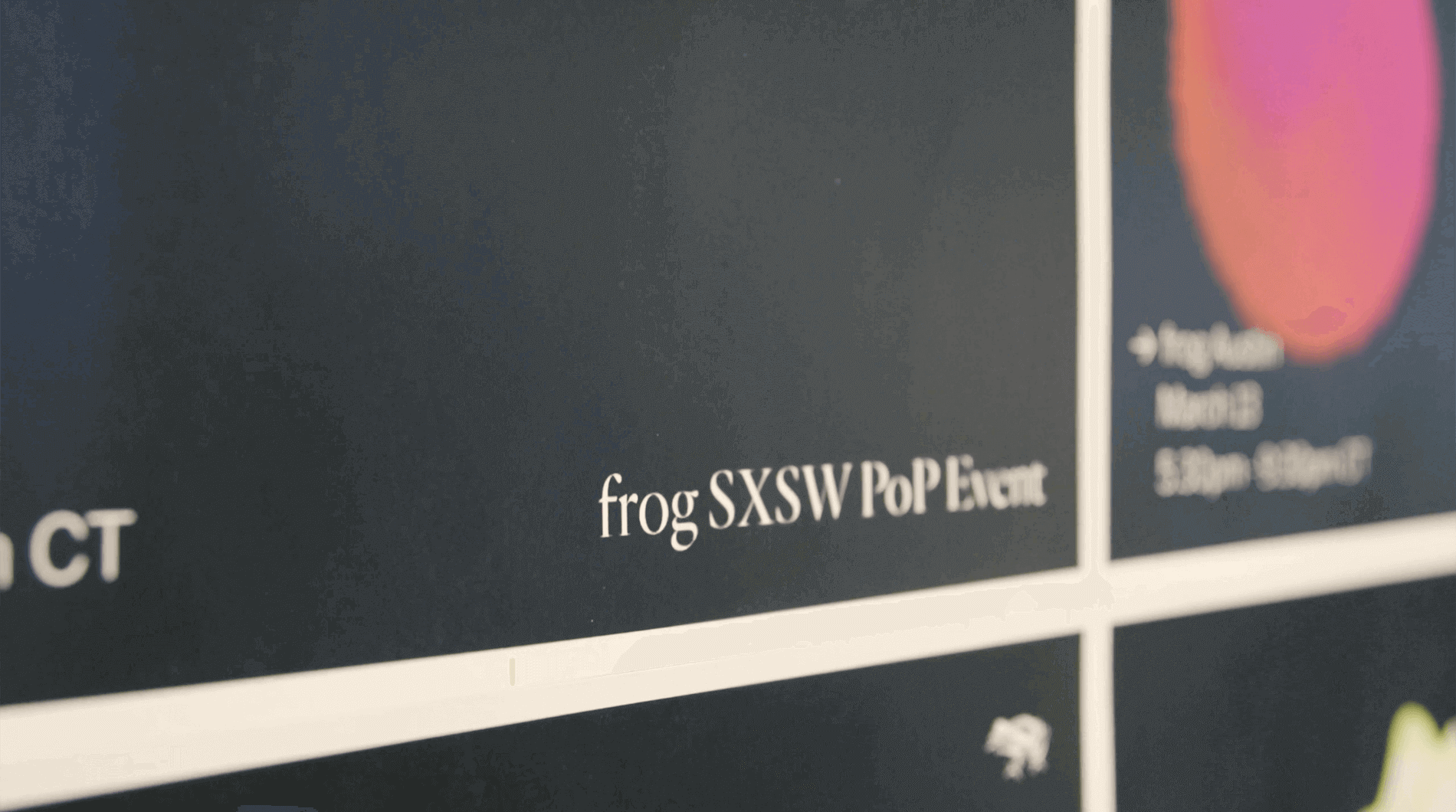
The Room of Urgency: Embracing the Ephemeral
What happens when we embrace the ephemeral and explore the impermanence of AI-generated imagery?
At this year’s SXSW Festival, frog explored this question and others in a series of on-site “provocation rooms.” Each room focused on the power of provocation to stimulate thought.
Nothing lasts forever, especially in a rapidly changing business landscape. And when it comes to acting on creativity, timing is everything. In the ‘Room of Urgency,’ frog hosts invited guests to tap into AI to generate ideas fast.
The Room of Urgency was divided into two zones in order to explore the idea of ephemerality. This is how it worked:
- Visitors in Zone 1 were given a common phrase as they entered.
- They then had to enter prompts into Midjourney, an AI tool that can generate images. These images were then transmitted wirelessly to a video monitor in Zone 2.
- Then, visitors in Zone 2 had to guess what the phrase was from the images created before a timer ran out.
This exercise was profound because it upended the norm, which is—or was—reliance on the designer as maker. Traditionally, design professionals were the ones who created imagery or a manifestation of an idea or concept. But with tools like Midjourney, now AI can quickly manifest ideas, signaling a new way of doing business with design.
Getting Down to Business With the Ephemeral
Phrases entered into Midjourney by one zone were unseen by the opposing zone. This meant that recipients of an image in either zone could only depend on interpretation gleaned from memory and personal knowledge to guess correctly. They also had to rely on an image that potentially deviated from the original idea, or from their own personal interpretation.
For example, if the prompt is the idiom “the grass is always greener on the other side,” AI might generate an image that’s a few steps removed from that. If someone were to enter a more specific prompt, such as “blades of grass with a fence down the middle—green on one side brown on the other,” the user might get something closer to what was intended. But the tool is going to interpret the prompt in its own way. Yet even with commonly used phrases, the team said it was sometimes challenging for people to enter prompts to create something that could be easily understood and communicated.
The team set out to activate different senses and memory, since memory is something we all have access to within our business context. The goal was to place everyone on an even playing field. The frog team wasn’t asking people to make anything, instead they were asking people to use the tool to pull from memory, as things are ephemeral and fleeting.
A Captivating First Experience with AI Imagery
The makers of The Room of Urgency intended for the room to be accessible to people who are not tech savvy, who are not designers and who do not have prior experience with AI software. For many, it was a captivating first experience with AI-generated imagery. People who didn’t know about an AI tool like Midjourney or hadn’t been exposed to it, had the opportunity to enjoy this novel, weird, unexpected and exciting experience.
AI is changing the way business operates. AI tools like Midjourney, ChatGPT and others are simplifying many processes. These game-changing technologies are set to alter the reality of the designer, asking them to redefine and fully express their added value in this new paradigm.
As individuals navigate the dubious elements present within this landscape, people are asking questions they never asked before. These are questions like:
- What will become of this new creativity energy shift? With AI, the designer no longer needs to put all of their energy toward making. Now, they can use prompts to spark ideas and understand other people’s thought processes.
- What is the authenticity of what the AI is generating?
- Can AI interpret what was previously uninterpretable?
- Before, the who was never in doubt when a drawing, home or app was designed by an individual, team or architect. With the emergence of AI, the question becomes who is really designing—the designer or the tool?
- If AI tools can design, what is the designer bringing to the table, and what is their new added value?
- Will the designer’s new role be adding, revising, building or evolving the generated design?
We’re All Authors
From a business perspective, it’s important that people with varying degrees of exposure understand how AI might change their business activities, even if interacting directly with AI isn’t part of their day-to-day. The Room of Urgency also revealed what people have available at their fingertips for use right now. Designers, providing added value, are authors, but not necessarily the only ones.
Coming up with prompts for AI tools puts people in a designer mindset. It becomes about pushing things forward, creating something new and experiencing the dopamine hits that come from innovation.
This is what we do at frog to deliver excellent results to our clients—we keep pushing things. The Room of Urgency reminds us that even with constraints like the ephemeral, we can push to generate greatness.
This was the second in a series of five blog posts that explore the power of provocation, inspired by frog’s presence at SXSW 2023. Check out the first article in the provocation room series, The Room of Nothing, where we’re urged to quiet our minds and bring brilliance. Please drop by again to learn about how provocations can inspire and shape the creative process. Take a peek into the electrifying atmosphere within frog’s innovative provocation spaces in a short video below.

 Play video
Play videoAlso written by Hunter Long, frog alum

Mike Prusaitis is a seasoned leader with 9+ years of expertise guiding cross-disciplined product teams from concept to launch. Mike wears a lot of hats. His versatility shines, donning roles as a product owner, scrum master, project manager, business analyst, account manager, and quality assurance tester, as needed.
Mike is a staunch advocate of streamlined processes and precision to boost project velocity. Yet, he’s also agile, switching gears when required to ensure seamless navigation from point A to B. His primary functions revolve around orchestrating the right talent, at the right time, armed with the right insights—making every beat count.

With over a decade of experience in visual design, Matt’s skill set encompasses a wide spectrum of design disciplines including branding, interface design, high-fidelity prototyping, and design language systems. Matt has an affinity for tabletop games, drinking coffee, traveling and watching videos of people building things on YouTube.
Some of Matt’s previous clients include IBM, Stanford Health Care, AWS Amplify Studio, Whataburger, USAA, Frost Bank, Shiner Beer, SXSW, NBC Universal, Dell, Austin Film Society, The City of Columbia, South Carolina, and Dimensional Fund Advisors.
We respect your privacy
We use Cookies to improve your experience on our website. They help us to improve site performance, present you relevant advertising and enable you to share content in social media. You may accept all Cookies, or choose to manage them individually. You can change your settings at any time by clicking Cookie Settings available in the footer of every page. For more information related to the Cookies, please visit our Cookie Policy.